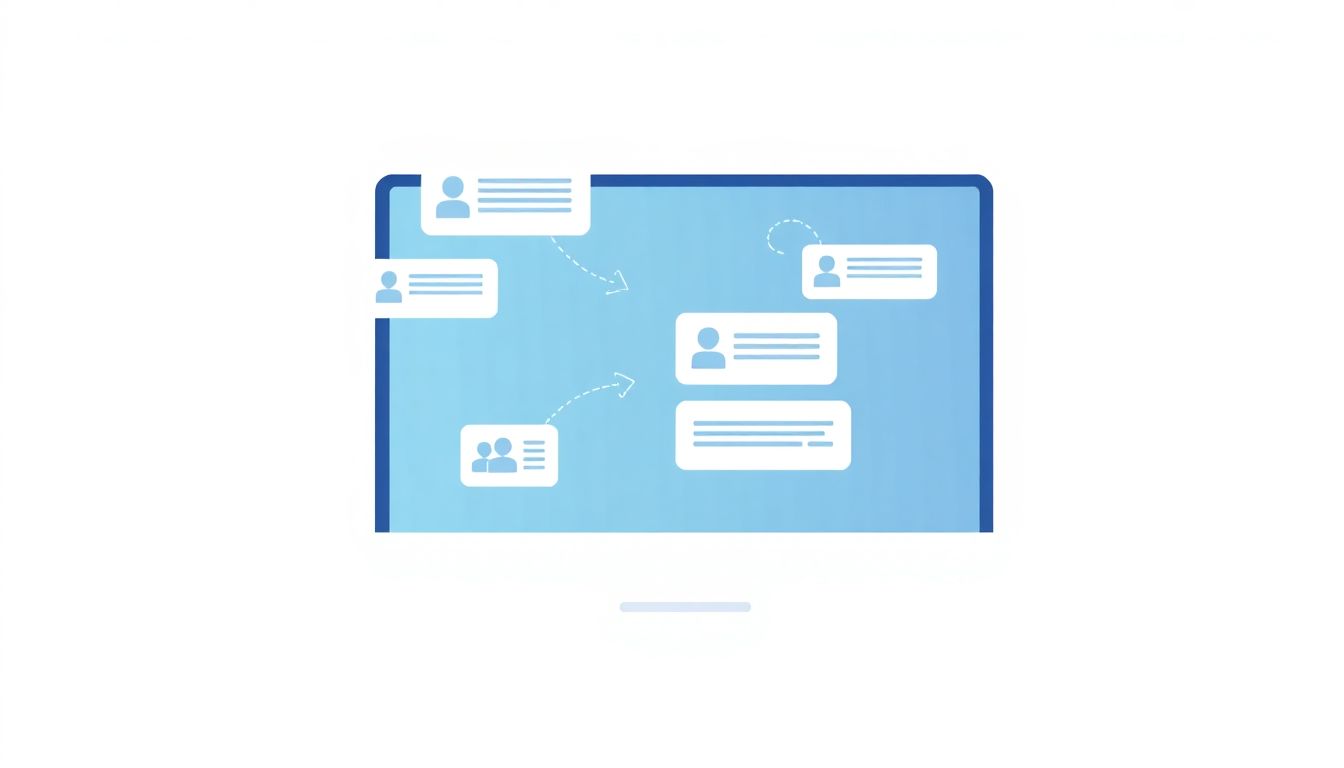Integrating ChatGPT into your CRM system might feel like a daunting task. You may wonder how this advanced AI can genuinely enhance customer engagement and if the effort is worth it. It’s perfectly normal to question whether a bit of tech wizardry can really make a difference in your everyday operations.
But hang tight! If you keep reading, I promise you’ll discover valuable insights and easy steps to effectively weave ChatGPT into your CRM processes, leading to stronger customer connections and more engaging interactions.
From understanding the myriad benefits to exploring common use cases, we’ll take a leisurely stroll through the essentials of integrating ChatGPT with your CRM, ensuring you have all the tools to boost engagement and delight your customers.
Key Takeaways
- Integrating ChatGPT into your CRM enhances customer engagement and operational efficiency.
- Ensure your CRM supports API integrations, create API keys, and set up ChatGPT for smooth operation.
- Automate responses to speed up customer service and provide 24/7 support.
- Use customer data for personalized interactions and improve satisfaction and loyalty.
- Monitor performance regularly using KPIs like response times and customer sentiment.
- Stay aware of challenges such as data privacy and technical difficulties during integration.
- Be ready for future trends like predictive analytics and multi-channel support in customer interactions.

How to Integrate ChatGPT into CRM Systems for Improved Customer Engagement
Integrating ChatGPT into your CRM system can significantly enhance customer engagement.
Start by ensuring you have access to a compatible CRM platform that allows API integrations.
Next, review your CRM’s documentation to understand how to implement external applications.
To establish the connection, create an API key through your CRM’s settings.
After that, set up a ChatGPT API with OpenAI, inputting your new API key into the system.
Give your team a heads-up about ChatGPT’s capabilities to streamline training and onboarding.
Finally, test the integration in real scenarios to ensure everything runs smoothly.
For a practical example, you could use this prompt during testing: “Generate a relevant response for a customer asking about their order status.”
Benefits of Using ChatGPT in CRM for Businesses
Using ChatGPT can offer numerous benefits for businesses, primarily by enhancing operational efficiency.
One major advantage is the ability to automate customer interactions, thereby reducing response times.
This automation not only frees up human agents but also allows for 24/7 support.
Moreover, ChatGPT can personalize communication based on customer data, improving satisfaction and loyalty.
Think about how delighted your customers will be receiving tailored recommendations or support based on their past interactions.
Additionally, ChatGPT can assist in lead generation by responding immediately to inquiries and qualifying leads.
Ultimately, these benefits can contribute to a healthier bottom line through improved sales and customer retention.
Step-by-Step Guide to Setting Up ChatGPT with Your CRM
Here’s a straightforward guide to set up ChatGPT with your CRM.
- Identify Your CRM: Make sure your CRM supports API integrations.
- Create an API Key: Go to your CRM settings, and create a new API key.
- Set Up ChatGPT API: Sign up for an OpenAI account and get your ChatGPT API key.
- Connect the APIs: Use your CRM’s integration options to input the ChatGPT API key.
- Configure User Interface: Customize how ChatGPT will interact with customers in your CRM dashboard.
- Run Tests: Check if the integration works correctly by simulating customer interactions.
- Launch: Once satisfied with the tests, make the system live for your users.
For a quick prompt to test functionality, you can try: “Draft a friendly email response to a customer’s inquiry about a product return.”
Common Use Cases of ChatGPT in CRM Systems
There are several practical applications for ChatGPT within CRM systems.
One common use case is automating customer service queries, like handling FAQs and common issues.
Another area is sales support, where ChatGPT can assist sales reps with immediate data access or lead qualification.
Consider using ChatGPT to generate personalized marketing messages based on customer data, improving engagement rates.
ChatGPT can also help collect customer feedback through conversational surveys right within your CRM.
In addition, ChatGPT can facilitate onboarding processes through interactive guides to help new users understand the platform.
To make experimentation easy, use a prompt like: “List five common reasons why customers might choose to switch vendors.”
These use cases showcase how integrating ChatGPT can optimize various aspects of customer relationship management.
For further insights on leveraging AI, check out our post on ChatGPT for Customer Service and learn how to enhance your support strategies.
Looking for more creative applications? Discover prompts for Creative Writing that can inspire new content ideas.

Tips for Maximizing Engagement with ChatGPT in Your CRM
To get the most out of ChatGPT in your CRM, it’s essential to focus on maximizing engagement.
First off, personalize interactions by utilizing customer data to tailor responses.
Try using prompts like: “Craft a personalized welcome message for a new customer based on their recent purchases.”
Next, encourage customer feedback by asking open-ended questions in your interactions.
For instance: “What features would you like to see next in our service?” This shows customers that their opinions matter.
Another effective strategy is to monitor the responses ChatGPT generates.
Use prompts such as: “Analyze customer satisfaction based on previous inquiries and recommend improvements.” This can help identify weaknesses.
Lastly, keep refining the AI’s knowledge by regularly updating its data inputs.
You can prompt with: “Add new product features to the knowledge base for improved customer support.” This keeps the chat up-to-date.
Challenges to Consider When Integrating ChatGPT with CRM
There are various challenges to keep in mind when integrating ChatGPT with your CRM.
One major hurdle is technical difficulties, particularly during the integration phase.
Be prepared to troubleshoot, as issues may arise with API configurations. Try using prompts like: “Identify common API errors during integration and suggest solutions.”
Data privacy is another crucial concern; ensure that sensitive customer information is handled properly.
Utilize prompts such as: “Review privacy protocols for handling customer data in AI interactions.”
Resistance from team members may also occur, especially if they’re unfamiliar with AI systems.
Address this by providing thorough training and support: “Create a training guide for staff to effectively use ChatGPT in their roles.”
Lastly, be aware of the limitations of AI, as ChatGPT may not fully replace human interaction.
For a balanced approach, use prompts like: “Design a workflow that combines ChatGPT responses with human oversight for complex queries.”
Measuring the Impact of ChatGPT on Customer Engagement
Measuring the impact of ChatGPT on customer engagement is vital for ongoing success.
Start by establishing key performance indicators (KPIs) that align with your goals.
Common KPIs include response time, customer satisfaction scores, and engagement rates.
Use metrics such as: “Track the average time ChatGPT takes to resolve customer inquiries.” This helps gauge efficiency.
Another useful approach is to analyze customer interactions for sentiment analysis.
Employ prompts like: “Assess the sentiment of customer conversations over the past month to identify trends.” This can reveal insights into customer happiness.
Don’t forget to regularly gather feedback from customers about their experiences.
For effective feedback collection, use a prompt like: “Draft a follow-up survey asking customers to rate their experience with ChatGPT assistance.”
Finally, review your findings quarterly to identify patterns and make necessary adjustments.
Utilize prompts such as: “Summarize quarterly performance metrics of ChatGPT to deliver actionable insights.” This will keep your ChatGPT integration on track.
Future Trends: ChatGPT and CRM Development
Looking ahead, several trends are emerging in the intersection of ChatGPT and CRM.
One notable trend is the rise of predictive analytics, allowing AI to anticipate customer needs and provide recommendations.
Use prompts like: “List potential future customer needs based on purchasing behavior data.” This can enhance proactive customer service.
Another exciting direction is the integration of enhanced analytics tools to improve real-time decision-making.
To explore this, prompt with: “Analyze real-time data about customer behavior and suggest immediate engagement strategies.”
Additionally, advancements in natural language processing are expected to improve AI understanding and response accuracy.
As this evolves, consider prompts like: “Generate a FAQ based on common customer queries to improve response accuracy.”
Last but not least, the emergence of multi-channel support will gain traction, offering seamless customer experiences across various platforms.
Prepare for this by using prompts such as: “Outline a strategy for providing consistent responses across email, chat, and social media channels with ChatGPT.”

Tips for Maximizing Engagement with ChatGPT in Your CRM
To get the most out of ChatGPT in your CRM, it’s essential to maximize engagement.
Personalize interactions by using customer data to tailor responses based on previous interactions.
Craft prompts like: “Create a personalized follow-up message for a customer who recently purchased a product.”
Encourage customer feedback by asking open-ended questions within your chats.
For feedback, try using: “What improvements would you like to see in our service?” This shows you value their thoughts.
Monitor ChatGPT’s responses closely to ensure they align with your brand’s voice.
Use prompts such as: “Evaluate the tone and phrasing of ChatGPT responses for consistency with our brand guidelines.”
Regularly update ChatGPT’s knowledge base to keep information current and useful.
Utilize prompts like: “Incorporate recent product updates and FAQ changes into the knowledge base for ChatGPT.”
Challenges to Consider When Integrating ChatGPT with CRM
When integrating ChatGPT with your CRM, expect some hurdles along the way.
Technical difficulties can arise, especially during API configuration.
To address these issues, use prompts like: “List common API integration issues and their fixes for ChatGPT in CRM.”
Data privacy is crucial; always ensure sensitive information is securely managed and compliant.
To review protocols, prompt with: “Assess our data handling procedures for AI interactions to ensure customer privacy.”
Resistance from team members occurs, especially if they’re unfamiliar with AI tools.
Mitigate this by creating thorough training materials, such as: “Develop a comprehensive user manual for team members to learn ChatGPT functionalities.”
Always recognize that while AI is powerful, it shouldn’t entirely replace human interaction.
For a balanced workflow, consider prompts like: “Draft a hybrid workflow that allows for ChatGPT and human agents to assist customers together.”
Measuring the Impact of ChatGPT on Customer Engagement
Measuring the impact of ChatGPT is key to understanding its effectiveness.
First, establish key performance indicators (KPIs) that are aligned with your engagement goals.
KPI examples include average response time, customer satisfaction scores, and engagement rates.
To evaluate efficiency, use a prompt like: “Measure the average response time for ChatGPT interactions versus human agents.”
Next, analyze customer feedback trends to get a pulse on sentiment regarding their experiences.
Employ prompts like: “Conduct a sentiment analysis on customer feedback over the past quarter regarding ChatGPT interactions.”
Regularly solicit feedback from customers on their experiences to fine-tune your approach.
Use a prompt like: “Create a survey to gather customer impressions of their recent interactions with ChatGPT.”
Lastly, review and adjust your strategies quarterly based on data findings.
Utilize prompts such as: “Summarize the quarterly performance of ChatGPT and suggest actionable steps for improvement.”
Future Trends: ChatGPT and CRM Development
As we look to the future, several exciting trends in ChatGPT and CRM development are emerging.
Predictive analytics are set to play a larger role, allowing ChatGPT to anticipate customer needs based on historical data.
You can explore this with prompts like: “Identify likely customer needs based on trends in purchasing behavior.”
There’s also a trend towards better real-time data analytics, enhancing decision-making for customer engagement strategies.
For insights, prompt with: “Generate immediate customer engagement strategies based on live analytics data.”
Advancements in natural language processing will improve ChatGPT’s understanding and accuracy in responses.
To stay ahead, use prompts like: “Create a detailed FAQ section for ChatGPT based on the most common customer questions.”
Finally, multi-channel support is becoming crucial for seamless customer experiences across platforms.
Prepare with prompts such as: “Outline a unified strategy for engagement across social media, email, and chat using ChatGPT.”
FAQs
Integrating ChatGPT into CRM systems enhances customer support, automates responses, provides personalized interactions, and improves overall engagement, leading to higher customer satisfaction and retention rates while streamlining operational efficiency.
Common use cases include chatbots for customer inquiries, lead qualification, personalized marketing messages, automated follow-ups, and 24/7 customer support, providing seamless interactions that enhance user experience.
Challenges include ensuring data privacy, integrating with existing systems, managing user expectations, and maintaining conversational accuracy, which require careful planning and technical expertise to address effectively.
Businesses can measure impact through metrics such as customer satisfaction scores, response times, interaction volumes, conversion rates, and retention rates, using analytics tools to monitor performance and engagement trends.
